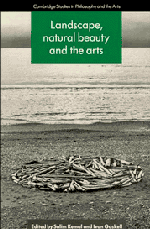Book contents
- Frontmatter
- Contents
- List of contributors
- Editors' acknowledgments
- 1 Nature, fine arts, and aesthetics
- 2 Natural beauty without metaphysics
- 3 Trivial and serious in aesthetic appreciation of nature
- 4 The public prospect and the private view: the politics of taste in eighteenth-century Britain
- 5 Landscape in the cinema: the rhythms of the world and the camera
- 6 The touch of landscape
- 7 Desert and ice: ambivalent aesthetics
- 8 Gardens, earthworks, and environmental art
- 9 Comparing natural and artistic beauty
- 10 Appreciating art and appreciating nature
- 11 The aesthetics of art and nature
- 12 On being moved by nature: between religion and natural history
- Index
5 - Landscape in the cinema: the rhythms of the world and the camera
Published online by Cambridge University Press: 03 May 2011
- Frontmatter
- Contents
- List of contributors
- Editors' acknowledgments
- 1 Nature, fine arts, and aesthetics
- 2 Natural beauty without metaphysics
- 3 Trivial and serious in aesthetic appreciation of nature
- 4 The public prospect and the private view: the politics of taste in eighteenth-century Britain
- 5 Landscape in the cinema: the rhythms of the world and the camera
- 6 The touch of landscape
- 7 Desert and ice: ambivalent aesthetics
- 8 Gardens, earthworks, and environmental art
- 9 Comparing natural and artistic beauty
- 10 Appreciating art and appreciating nature
- 11 The aesthetics of art and nature
- 12 On being moved by nature: between religion and natural history
- Index
Summary
Landscape seems to have been granted no place among the topics of argument in the aesthetics of the cinema. There is a vast literature on montage, language, the human face, the city, sound and silence, fiction and truth in film, but almost nothing on natural beauty. Yet from the very beginning films were made outdoors. Some of the first apologists for the cinema as an art made a point of the power and beauty of natural surroundings in film. Sergei Eisenstein, the most ambitious and thorough of film-maker-theoreticians, devoted the culminating essay of his career to “the music of landscape,” but it was the question of cinematic rhythm that really absorbed his attention at that time, as we shall see.
Although theoreticians describe cinematic landscapes in order to exemplify points, the topic itself is virtually an unconscious issue of film theory. In fact, it was not until the late 1960s and throughout the seventies that a genre of landscape cinema was created by European and North American avant-garde film-makers, and even then it was not until the 1980s that the aesthetic issues raised by these film-makers were recognized as such. In this essay I shall follow some preliminary remarks with a sketch of the ways in which the historical evolution of cinematic technology called forth changing evocations of landscape beauty. The third part surveys the predominance of meteorological phenomena as a function of the cinema's capability for rendering movement, while the fourth gives some examples of the integration of landscape issues into narrative contexts.
- Type
- Chapter
- Information
- Landscape, Natural Beauty and the Arts , pp. 103 - 126Publisher: Cambridge University PressPrint publication year: 1993
- 11
- Cited by



